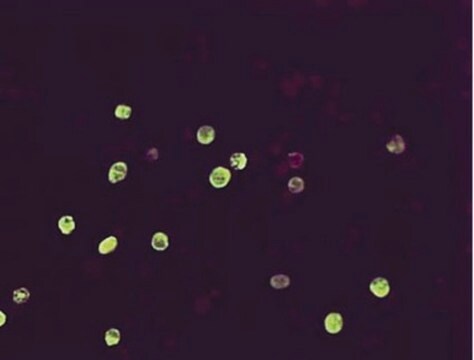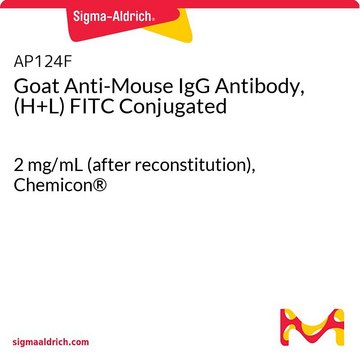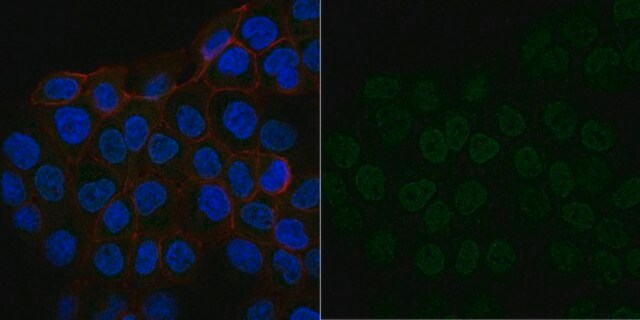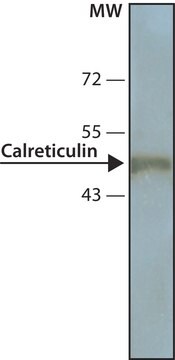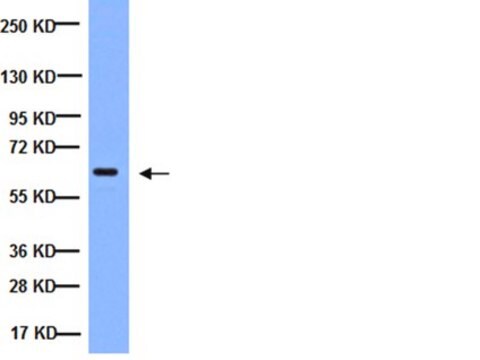おすすめの製品
由来生物
mouse
品質水準
抗体製品の状態
purified antibody
抗体製品タイプ
primary antibodies
クローン
227, monoclonal
化学種の反応性
human
メーカー/製品名
Chemicon®
テクニック
ELISA: suitable
immunocytochemistry: suitable
western blot: suitable
アイソタイプ
IgG1κ
輸送温度
wet ice
詳細
Protein X (UniProt: P69713; also known as HBx, Peptide X, pX) is encoded by the X gene (Gene ID: 944566) in Hepatitis B virus. Hepatitis B virus (HBV) contains seven main proteins, which include Core, pre-Core, Small S, Middle S, Large S, Polymerase, and the HBx protein. HBx, a multifunctional protein, although not essential for HBV infection, plays a role in silencing host antiviral defenses and promoting viral transcription. It facilitates the efficient replication of HBV by stimulating HBV gene expression from the cccDNA template. It is mainly localized in the cytoplasm with a small fraction detected in the nucleus. However, its expression level can also influence its cellular localization. It is predominantly nuclear when expressed in cells at very low levels but becomes largely cytoplasmic as its expression level increases. In cytoplasm, a minor fraction may also associate with mitochondria. Its mitochondrial targeting sequence is localized in amino acids 68-117. HBx has an N-terminal negative regulatory domain and its transactivation or coactivation of the C-terminal domain is reported to interfere with host cell signaling transduction pathways to help HBV replication. The best-characterized HBx binding partner is the cellular damage-specific DNA binding protein 1 (DDB1) and the interaction of HBx-DDB1 is essential for HBV replication. HBx promotes the degradation of the cellular structural maintenance of chromosomes 5/6 complex (Smc5/6), which directly binds DNA and entraps DNA plasmids. HBx is directly involved in development of cirrhosis and liver and hepatocellular carcinoma. (Ref.: Kornyeyev, D., et al. (2019). J. Virol. 93(16); e00248-19; Hwang, G-Y., et al. (2003). J. Clin. Microbiol. 41(12); 5598-5603).
特異性
Reacts with Hbx-protein (trans-activator X gene product) of hepatitis B virus (epitope recognized - amino acid positions 90-115).
SPECIES REACTIVITIES:
Reacts only with HBV-infected human cells.
SPECIES REACTIVITIES:
Reacts only with HBV-infected human cells.
免疫原
Epitope: X-Protein, aa 90-115
Peptide cooresponding to aa90-115 of h HBV-X protein.
アプリケーション
Research Category
感染症
感染症
Research Sub Category
感染症-ウイルス
感染症-ウイルス
Anti-Hepatitis B Virus Antibody, X-Protein, a.a. 90-115, clone 227 detects level of Hepatitis B Virus & has been published & validated for use in ELISA, WB & IC.
ELISA, immunoblotting and immunocytochemistry staining of infected liver tissues and HBV-transfected hepatoma cells. Optimal working dilutions must be determined by the end user.
物理的形状
Format: Purified
Liquid in 0.02M PBS pH 7.6, 0.25M NaCl containing 0.1% sodium azide.
保管および安定性
Maintain at 2-8°C in undiluted aliquots for up to 12 months.
その他情報
Concentration: Please refer to the Certificate of Analysis for the lot-specific concentration.
法的情報
CHEMICON is a registered trademark of Merck KGaA, Darmstadt, Germany
免責事項
Unless otherwise stated in our catalog or other company documentation accompanying the product(s), our products are intended for research use only and are not to be used for any other purpose, which includes but is not limited to, unauthorized commercial uses, in vitro diagnostic uses, ex vivo or in vivo therapeutic uses or any type of consumption or application to humans or animals.
適切な製品が見つかりませんか。
製品選択ツール.をお試しください
保管分類コード
10 - Combustible liquids
WGK
WGK 2
引火点(°F)
Not applicable
引火点(℃)
Not applicable
適用法令
試験研究用途を考慮した関連法令を主に挙げております。化学物質以外については、一部の情報のみ提供しています。 製品を安全かつ合法的に使用することは、使用者の義務です。最新情報により修正される場合があります。WEBの反映には時間を要することがあるため、適宜SDSをご参照ください。
Jan Code
MAB8419:
試験成績書(COA)
製品のロット番号・バッチ番号を入力して、試験成績書(COA) を検索できます。ロット番号・バッチ番号は、製品ラベルに「Lot」または「Batch」に続いて記載されています。
HBX causes cyclin D1 overexpression and development of breast cancer in transgenic animals that are heterozygous for p53.
Klein, A; Guhl, E; Tzeng, YJ; Fuhrhop, J; Levrero, M; Graessmann, M; Graessmann, A
Oncogene null
Accumulation of 8-hydroxy-2'-deoxyguanosine adducts in HBx recombinant HepG2 cells and HBx transgenic mice.
Ralph Gehrke, Maria A Brauchle, Kurt Reifenberg, Eberhard Hildt, Uwe Gruetzner et al.
Digestion null
Epigenetic modification induced by hepatitis B virus X protein via interaction with de novo DNA methyltransferase DNMT3A.
Da-Li Zheng, Li Zhang, Na Cheng, Xiao Xu, Qing Deng, Xiao-Mei Teng, Ke-Sheng Wang et al.
Journal of Hepatology null
T M Bui-Nguyen et al.
Oncogene, 29(8), 1179-1189 (2009-12-17)
Metastasis-associated protein 1 (MTA1), a master chromatin modifier, has been shown to regulate cancer progression and is widely upregulated in human cancer, including hepatitis B virus-associated hepatocellular carcinomas (HCCs). Here we provide evidence that hepatitis B virus transactivator protein HBx
KyeongJin Kim et al.
PloS one, 5(3), e8649-e8649 (2010-03-31)
Hepatitis B virus (HBV) is a major cause of chronic liver diseases, and frequently results in hepatitis, cirrhosis, and ultimately hepatocellular carcinoma. The role of HCV in associations with insulin signaling has been elucidated. However, the pathogenesis of HBV-associated insulin
ライフサイエンス、有機合成、材料科学、クロマトグラフィー、分析など、あらゆる分野の研究に経験のあるメンバーがおります。.
製品に関するお問い合わせはこちら(テクニカルサービス)
